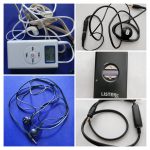June 25, 2024: It is important for me to tell you that most of the following information is cut and pasted from several different public web sites and blogs. The history of T-Coils, or telecoils, began in 1937 when Joseph Poliakoff of Great Britain patented the first magnetic induction loop communication system. The T-Coil is a small copper coil in a hearing aid that acts like an antenna to pick up a magnetic signal from an induction loop, or hearing loop, and allow the user to hear what’s being broadcast. The T-coil’s original purpose was to pick up the magnetic field from the copper coils inside a telephone, allowing the hearing aid user to clearly hear a phone conversation without background noise. The T-coil only picked up the audio signal from the phone, not any acoustical distortion, making the speaker’s voice more intelligible.
Eventually, someone discovered other uses for them. For example, by 1956, t-coils were being used to listen to radios and TVs via small loop pads.
 Here is an example of a miniature loop pad that Sonotone Corp. of Elmsford, NY produced around 1956. To use it, you clamped the two alligator clips across the terminals of the radio or TV’s loudspeaker. Then you switched on the t-coil and placed the body-worn hearing aid on the loop pad instead of in your pocket and voila, you had a simple loop system. (I acquired the loop pad shown here along with this Sonotone Model 200 4-transistor body-worn hearing aid that came out in 1956.)
Here is an example of a miniature loop pad that Sonotone Corp. of Elmsford, NY produced around 1956. To use it, you clamped the two alligator clips across the terminals of the radio or TV’s loudspeaker. Then you switched on the t-coil and placed the body-worn hearing aid on the loop pad instead of in your pocket and voila, you had a simple loop system. (I acquired the loop pad shown here along with this Sonotone Model 200 4-transistor body-worn hearing aid that came out in 1956.)
Room loops started to be installed in the early ’70s. This was followed with low powered radio frequency transmission to hearing devices resembling Walkman portable radios. When a venue chooses this solution to meet ADA hearing loss compliance people are offered a small battery powered receiver that is equipped with a wired ear phone and a T-
Coil enabled lanyard. Because I have T-Coil enabled hearing aids I choose the T-Coil receptive lanyard. Then I just push the button on my hearing aid and the audio then plays directly into my ear. The clarity is amazing! The other choice is to use either the supplied ‘D’ style ear piece or bring your own earbuds to use. Also, assuming you can determine what frequency is used by the venue’s radio transmitter you can use a walkman type radio capable of receiving at that frequency.


Comments
Layman explanation of T-Coils — No Comments
HTML tags allowed in your comment: <a href="" title=""> <abbr title=""> <acronym title=""> <b> <blockquote cite=""> <cite> <code> <del datetime=""> <em> <i> <q cite=""> <s> <strike> <strong>